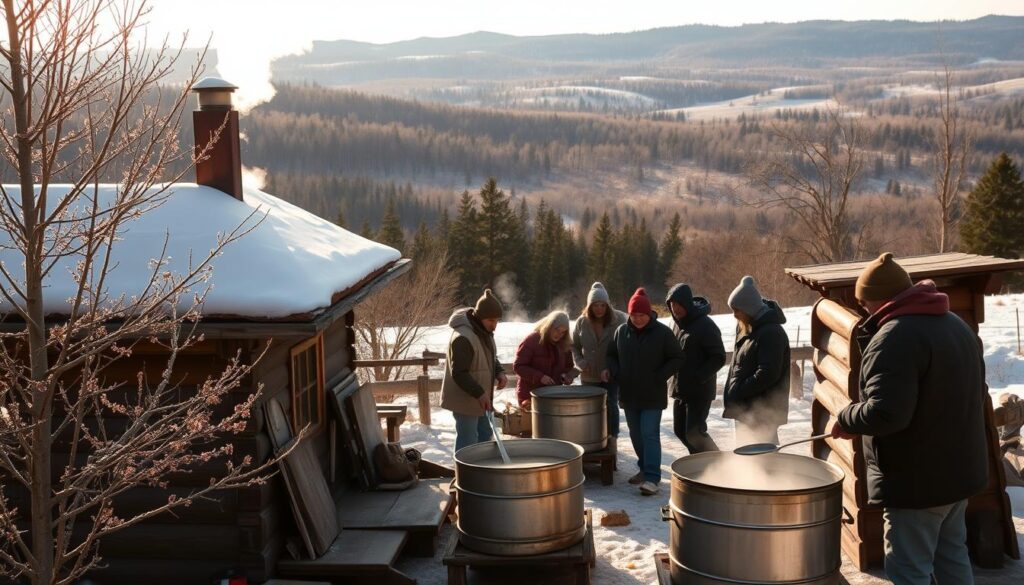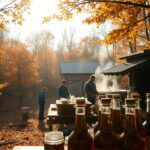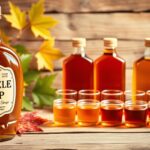Every spring, North American forests turn into a magical place filled with sweet possibilities. This tradition connects nature’s wonder with the art of cooking. It’s a time when maple trees share their secret treasure.
The sugaring season is more than just making syrup. It’s a celebration that goes deep into North American culture.
When nights are cold and days are warm, maple trees start to flow sap. Sugarmakers get ready, waiting for the perfect moment to collect it. The season usually lasts from late February to early April, depending on where you are.
Indigenous people first learned about this amazing process long ago. They taught early settlers how to make maple syrup. Now, places like Vermont, New York, and Canada make millions of gallons every year.
The magic of the Maple Syrup Season comes from the perfect mix of nature. Sugarmakers watch the temperature closely. They know that the right time is key to making great syrup.
For food lovers, chefs, and families, this season is exciting. The chance to taste fresh, golden maple syrup brings people together. It celebrates a tradition that turns tree sap into something truly special.
Understanding the Magic of Maple Syrup Season
Maple syrup harvesting is a mix of nature and science. It starts with a special process that turns maple trees into liquid gold in early spring.
The journey of maple syrup production begins inside the tree. Here, temperature and pressure control the flow of sap.
The Science Behind Sap Flow
Maple trees store starches in their roots and trunk during winter. When it gets colder at night and warmer during the day, these starches turn into sugar. This creates the sweet liquid that sugarmakers collect.
- Freezing nights cause tree tissues to contract
- Warm daytime temperatures create positive pressure
- This pressure pushes sap through the tree’s vascular system
Optimal Weather Conditions
Good weather is key for maple syrup harvesting. The best conditions include:
| Temperature Range | Sap Production Impact |
|---|---|
| Below 32°F at night | Creates negative pressure in tree |
| Above 40°F during day | Generates positive pressure and sap flow |
Peak Harvesting Times
Sap collecting happens from late February to early April. The most productive time is about 4-6 weeks. The exact time can vary based on local weather.
Each maple syrup season offers a special chance for sugarmakers. They must time their efforts perfectly to catch nature’s sweet gift.
The Rich History of North American Maple Syrup Production
The maple syrup industry started with the indigenous peoples of North America. They first found the sweet sap of maple trees. Before European settlers came, Native American tribes already knew how to collect and process this sap.
“Maple syrup was a gift from the forest, a treasure that connected our people to the land,” noted a traditional indigenous elder.
Indigenous communities used clever ways to get sap from trees. They made V-shaped cuts and used hollowed-out bark to collect it. Their ancient knowledge helped start the maple syrup industry we know today.
- Indigenous tribes first discovered maple sap processing techniques
- European settlers learned maple syrup production from Native Americans
- Traditional methods evolved into modern commercial production
European settlers soon adopted these methods. They turned maple syrup making into a big business. By the 1800s, places like Quebec, Vermont, and Ontario were key in the maple syrup world.
| Time Period | Maple Syrup Production Milestone |
|---|---|
| Pre-1600s | Indigenous maple sap harvesting techniques |
| 1700s | European settlers learn maple syrup production |
| 1850s | First commercial maple syrup operations |
| 1900s | Technological innovations in maple syrup processing |
In the 20th century, the maple syrup industry kept getting better. Technological advancements made old sugar bush ways into big, modern factories. Yet, they kept the craft’s cultural heart alive.
Identifying the Perfect Maple Trees for Tapping
Choosing the right maple trees is key for a good syrup harvest. Not every maple tree is good for making sweet syrup.
To pick the best trees, you need to know a few important things. These things help make sure you get lots of sap.
Sugar Maple: The Preferred Species
The sugar maple is the top choice for tapping. It has the most sugar and gives the most sap.
- Sugar maple (Acer saccharum) contains approximately 2% sugar content
- Produces the sweetest and most concentrated sap
- Native to northeastern North America
Tree Age and Size Requirements
Maple trees need to be the right age and size for tapping. Sugarmakers know how to tap without harming the trees.
| Tree Diameter | Tapping Recommendations |
|---|---|
| 10-20 inches | One tap per tree |
| 20-25 inches | Two taps maximum |
| Over 25 inches | Three taps maximum |
Health Indicators for Successful Tapping
It’s important to pick healthy maple trees. Look for trees with:
- Intact bark without significant damage
- Strong, symmetrical branch structure
- No signs of disease or pest infestation
- Vigorous growth in surrounding forest environment
By choosing and caring for maple trees well, sugarmakers can make lots of syrup.
Essential Tools and Equipment for Maple Syrup Harvesting
Maple syrup production needs special tools to make tree tapping efficient. The right gear can boost syrup quality and amount.
At first, maple syrup makers used wooden buckets and metal spouts. Now, they have modern tech to make harvesting easier.
- Tapping tools: Cordless drills and special maple tapping bits replace old augers
- Collection systems: Plastic tubing networks are better than hanging buckets
- Vacuum pumps: Help move sap faster and more efficiently
- Sanitization equipment: Keeps collection clean and stops bacteria
Today’s maple syrup making uses new tech that keeps tradition alive. Vacuum systems can raise sap collection by 50% over old methods.
Important tools for making maple syrup include:
- Tapping equipment
- Collection systems
- Transportation tools
- Filtration and processing gear
Sugarmakers buy top-notch tools to care for maple trees and get more syrup. The right tools help harvest sustainably, keeping forests healthy.
Modern Maple Syrup Production Techniques
The syrup making process has changed a lot with new technology. Now, maple producers use both old and new ways to make syrup. This mix ensures top-quality syrup.
Today, maple syrup making uses smart methods to improve efficiency and quality. Sugarmakers use new ideas to keep the syrup’s true taste. This is what maple fans love.
Evaporation Systems
Modern syrup makers use advanced evaporation systems. These systems help concentrate sap better:
- Reverse Osmosis (RO) technology
- Multi-stage evaporators
- Energy-efficient wood-fired systems
- Digital temperature monitoring equipment
“Technology has revolutionized maple syrup production without compromising its traditional essence.” – Maple Industry Expert
Filtering Methods
Modern producers use precise filtering to keep syrup pure. They use several filters to remove impurities. This keeps the syrup clear and clean.
- High-pressure filter presses
- Micro-filtration systems
- Temperature-controlled filtering processes
Quality Control Measures
Quality control is key in syrup making. Producers test syrup thoroughly to ensure it’s the best:
- Consistent sugar content verification
- Color and clarity assessments
- Flavor profile evaluations
- Microbial contamination screening
These modern methods show how technology improves syrup making. Yet, they keep the syrup’s true taste and quality.
The Traditional Sugar Shack Experience
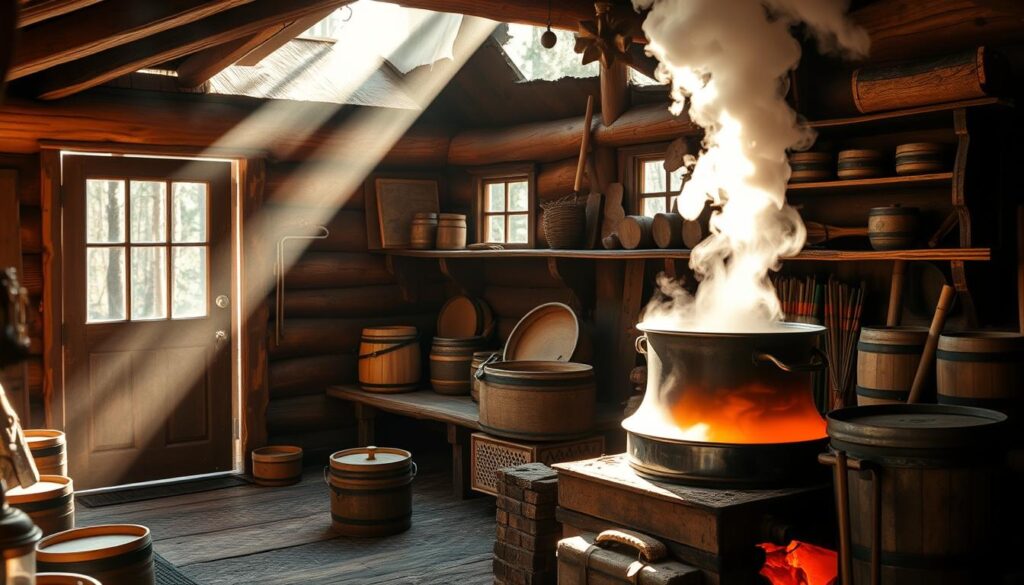
The sugar shack is a key part of maple syrup making in North America. These wooden buildings are more than just places to work. They hold the traditions of many generations.
Walking into a sugar shack is like entering a different world. You’re hit with the smell of boiling maple sap and the cozy feel of wood-fired stoves. Sugar shacks do many things:
- They turn raw maple sap into syrup
- They host community events
- They keep maple syrup making alive
- They teach people about maple syrup history
Inside, you’ll find big copper or stainless steel pans, wood stoves, and places to store syrup. Family-owned shacks often show off old tools and photos. This creates a warm, nostalgic feel that links today to yesterday.
In maple syrup season, sugar shacks become places where families and friends come together. Traditional maple syrup meals like pancakes and sugar pie are served. These meals turn sugar shacks into places of joy and celebration.
From Tree to Table: The Syrup Making Process
The maple syrup season turns nature’s sweet liquid into a culinary treasure. Sugarmakers carefully turn raw maple sap into a delicious golden nectar. This nectar is enjoyed on breakfast tables across North America.
Maple syrup production needs precision and expertise. Each step requires careful attention and understanding of the complex transformation from tree sap to syrup.
Sap Collection Methods
Modern maple syrup production uses two main sap collection techniques:
- Traditional Bucket System: Individual buckets hung directly on maple trees
- Tubing Network: Interconnected plastic tubes connecting multiple trees for efficient sap collection
Boiling Techniques
The boiling stage is key in the syrup making process. Sugarmakers heat the sap to concentrate its sugars. This turns the thin, watery liquid into rich, thick syrup.
- Initial heating removes water content
- Continuous monitoring prevents burning
- Temperature control ensures proper sugar concentration
Grading and Classification
Maple syrup gets grades based on color and flavor intensity. Professional graders check each batch for consistent quality and taste.
Maple syrup represents a delicate balance between nature’s generosity and human craftsmanship.
Sustainable Practices in Maple Syrup Production
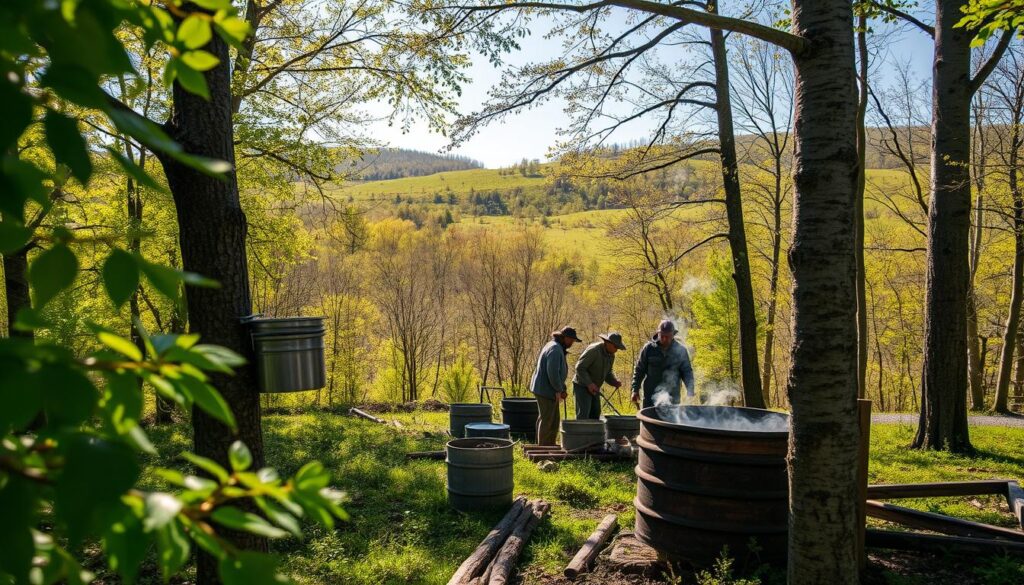
The maple syrup industry is leading the way in environmental care. It uses new methods to protect forests and keep syrup quality high. Sugarmakers have come up with smart ways to keep maple trees and forests healthy for the long run.
It’s all about sustainable tapping to keep the balance in the maple syrup world. Producers follow strict rules to avoid harming trees and help forests grow back:
- Limiting tap holes per tree based on diameter
- Using specialized tapping techniques that reduce tree damage
- Rotating tapping locations to allow tree recovery
Energy efficiency is key in making maple syrup today. Renewable energy sources are changing how syrup is made:
| Energy Source | Environmental Impact | Efficiency Rating |
|---|---|---|
| Solar Thermal Systems | Low Carbon Emissions | High |
| Biomass Heating | Sustainable Wood Waste | Medium-High |
| Geothermal Energy | Minimal Environmental Disruption | Very High |
Water saving is also a big part of making maple syrup right. New systems for filtering and recycling water help use less water while keeping syrup quality up.
The future of the maple syrup industry depends on our commitment to environmental preservation and sustainable practices.
Economic Impact of the Maple Syrup Industry
The maple syrup industry is more than just sugar making. It’s a big deal in the forests of North America. It brings in a lot of money and helps out many rural areas.
In recent years, the maple syrup business has really taken off. It’s moved from a traditional farm activity to a major economic force. Producers in Canada and the U.S. see more people wanting their high-quality syrup.
Market Trends and Statistics
Market studies show the maple syrup industry is on the rise:
- Annual production values exceed $500 million in North America
- Steady growth rate of 4-5% per year in global market
- Increasing consumer preference for natural sweeteners
Global Trade Impact
Maple syrup is a hit worldwide as a top-notch farm product. The global trade scene shows strong interest in this special item.
| Country | Export Volume (Metric Tons) | Market Share |
|---|---|---|
| Canada | 72,000 | 71% |
| United States | 21,000 | 21% |
| Other Countries | 8,000 | 8% |
The maple syrup industry is strong and keeps growing. It’s all thanks to new ways of making syrup and more people knowing about it.
Cultural Significance and Traditional Celebrations
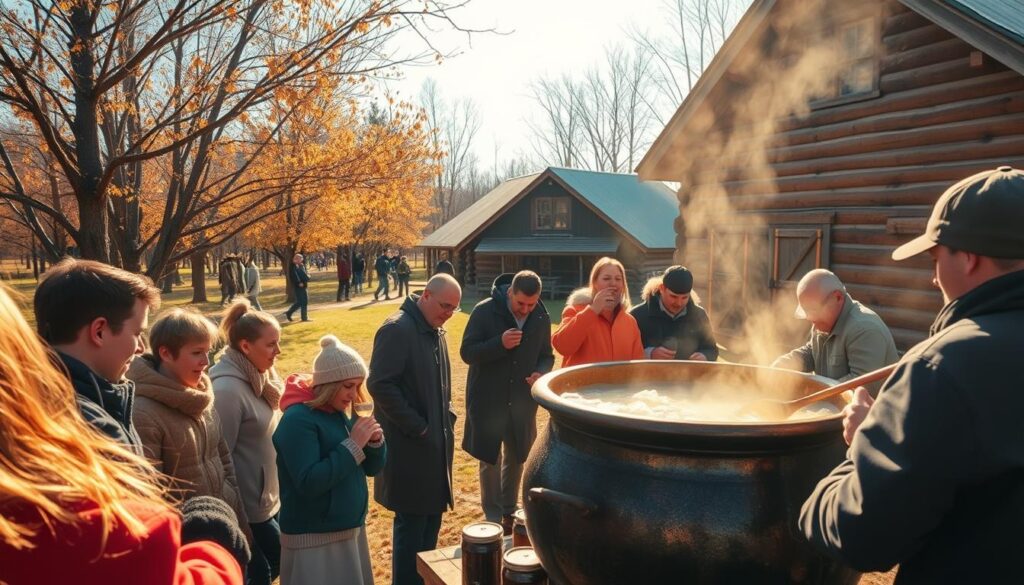
The Maple Syrup Season is more than just a time to harvest sugar. It’s a celebration of North American traditions. Communities in maple-producing areas hold festivals and rituals that honor their agricultural roots.
During maple syrup season, communities come together for special events. These events highlight the region’s maple pride through various activities:
- Sugar-on-snow parties with fresh maple syrup on clean snow
- Maple syrup tastings to show off different flavors
- Demonstrations of how to tap and boil maple sap
- Local maple syrup cooking competitions
Maple syrup is more than just food. Indigenous communities first discovered maple sap collection. They shared their knowledge with future generations. This knowledge is the base of maple syrup production in northeastern regions.
| Region | Cultural Celebration | Significance |
|---|---|---|
| Quebec, Canada | Cabane à Sucre | Annual family gathering celebrating maple harvest |
| Vermont, USA | Maple Open House Weekend | Statewide event showing off local sugar shacks |
| New Hampshire | Maple Festival | Community celebration of sugaring season |
Maple syrup is a key ingredient in many dishes, making it a cultural symbol. It’s used in maple-glazed foods and traditional desserts. The sugaring season is a time for community, heritage, and the bond between people and nature.
Health Benefits and Nutritional Value of Pure Maple Syrup
Pure maple syrup is more than just a sweetener. It’s a natural food with a unique nutritional profile. Made from maple tree sap, it’s packed with minerals and compounds that are good for your health.
Mineral Powerhouse
Maple syrup is a great source of essential minerals. Here’s what you get from just one serving:
- Manganese: Supports bone health and metabolism
- Zinc: Boosts immune system function
- Calcium: Promotes strong bones and teeth
- Potassium: Regulates heart and muscle functions
Antioxidant Properties
Research has found something amazing in maple syrup. It has powerful antioxidants that protect cells from damage. Studies suggest it has up to 24 different antioxidants, like berries and other nutrient-rich foods.
Adding maple syrup to your diet is more than just sweetening it. It’s a natural choice that offers nutritional benefits. It’s a better choice than refined sugars, helping you stay healthy with every drizzle.
Maple Syrup Storage and Preservation Tips
Keeping maple syrup fresh is key. Both sugarmakers and home cooks must pay close attention to storage. The right methods can keep the syrup’s flavor and quality for longer.
Storage conditions are very important. You need to keep the syrup away from temperature changes and contamination.
- Store unopened maple syrup in a cool, dark place
- Keep containers tightly sealed to prevent moisture and contaminants
- Refrigerate after opening to maintain freshness
Temperature management is essential in maple syrup harvesting preservation. The storage method depends on how long you want to keep the syrup:
| Storage Location | Duration | Temperature Range |
|---|---|---|
| Pantry (Unopened) | Up to 1 year | 50-70°F |
| Refrigerator | 1-2 years | 32-40°F |
| Freezer | Indefinite | 0°F or below |
“The secret to perfect maple syrup is not just in the harvesting, but in the careful preservation,” says a veteran maple syrup producer.
Look out for spoilage signs. Crystals, mold, or bad smells mean the syrup has spoiled. To avoid crystals, keep the syrup at a steady temperature and don’t heat and cool it too often.
- Always use clean utensils when handling syrup
- Check sealed containers for any signs of damage
- Transfer small amounts to a separate container for immediate use
Conclusion
The Maple Syrup Season is more than a food tradition. It’s a story of science, culture, and green farming. It shows how tapping maple trees and making syrup connects people across North America.
Maple syrup making mixes old ways with new tech. New ways to harvest and filter sap, and strict quality checks, keep the tradition alive. This work also helps local farms and boosts the economy.
Enjoying Maple Syrup Season means loving nature and food art together. As people want real, natural foods, maple syrup is a top choice. It’s perfect for pancakes or as a fancy ingredient, loved by food lovers everywhere.
If you’re interested in this special time, try it out yourself. Seeing maple syrup go from tree to table is a unique experience. It’s a celebration of nature’s sweetest gift.

